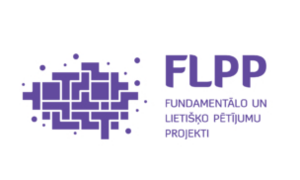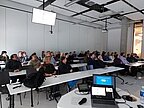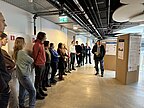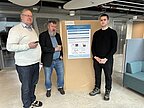

Project title: Laser Photodetachment Spectroscopy on Negative Ions
Project contract number: lzp-2023/1-0199
Project implementation deadline: 01.01.2024. - 31.12.2026.
Total project funding: 300 000,00 EUR
Research manager: Dr. Hab. phys. Uldis Bērziņš
Planned project results:
• original scientific articles the quoting index whereof reaches at least 50 per cent of the average quoting index of the sector which have been submitted or accepted for publication in the journals or conference symposia included in Web of Science Core Collection or SCOPUS databases – 4
• original scientific articles submitted or accepted for publication in the journals or conference symposia included in Web of Science Core Collection or SCOPUS databases – 6
• other peer-reviewed scientific articles, which have been published in, submitted for, or accepted by international magazines and collections of articles, except for conference materials – 3
• conference materials (except for those indexed in SCOPUS and Web of Science Core Collection):– 4
• manuscripts of scientific articles included in manuscript databases (preprints) and other publications published under the responsibility of the authors (non-reviewed)– 1
• patents – 1
• project proposal submitted in an international or national call for research and development projects – 3
• successfully defended master’s thesis within the thematic focus of the project – 2
• doctoral thesis successfully defended according to certain procedures within the thematic focus of the project – 1
Project Summary:
During the project, studies of the structure and dynamics of negative ions will be performed with the aim of improving our knowledge and understanding of atomic systems in which electron correlation effects play a major role. Spectroscopic measurements of the process of removing an electron from negative ions will be studied. Several experimental equipment will be used for the work. Initial experiments will be carried out on the ion beam equipment GRIBA (Gothenburg Riga Ion Beam Accelerator), which is located at the Institute of Atomic Physics and Spectroscopy, using the TOF (Time of Flight) spectrometer. Information on the structure of negative ion energy levels will be obtained. The obtained information will make it possible to plan the scheme of the experiment and the necessary (mainly lasers) for high-precision measurements on very advanced experimental equipment at Europe's leading science facilities: GANDALPH at CERN, and DESIREE at Stockholm University. Finally, high-precision data will be obtained and will be published in the world's leading journals and reported at conferences. Senior scientists will work on the project together with MSc, BSc and PhD students. Their results will be used in their PhD, master and bachelor thesis. The data for negative ions are needed by specialists in various fields of science and technology: atomic and molecular physics, nuclear physics, astrophysics, atmospheric photochemistry, medicine, semiconductor industry, energetics etc.
Project participants:
Dr.Hab.Phys Uldis Bērziņš, project leader
Asoc. Prof., Full Member of the Latvian Academy of Sciences Jānis Alnis, lead researcher
Dr.Phys. Jānis Sniķeris, researcher
PhD candidate Arturs Ciniņš, izpildītājs
Student (LU Physics) Kalvis Kalniņš, laboratory assistant
Student (LU Physics) Alberts Bilzēns, laboratory assistant
Student (LU Physics) Matīss Čakšs, laboratory assistant
Cooperation partners:
Prof. Dag Hanstorp and research group, University of Gothenburg, Sweden
Prof. Henrik Hartman, Malmö University, Sweden
Prof. Henning Schmidt and DESIREE laboratory, Stockholm University, Sweden
Prof. Rashid Ganeev and Dr. Vyacheslav Kim, TIIAME National Research University, Institute of Fundamental and Applied Research, Tashkent, Uzbekistan
Dr. Erich Leistenschneider, ISOLDE, CERN, Switzerland and Lawrence Berkeley National Laboratory, USA
Prof. Daniel Gibson and Prof. Wes Walters, Ohio State University, USA


Publicity
Prof Daga Hanstorp visit to Riga
Public lecture at the University of Latvia Science House on the Use of Lasers in Various Fields of Physics and at Riga State Gymnasium 3 on Alfred Nobel and the Nobel Prize


82nd International Scientific Conference of the UL
On February 15, 2024, as part of the 82nd International Scientific Conference of the University of Latvia, a poster session 'Atomic Physics, Optical Technologies and Medical Physics' was held at the Institute of Atomic Physics and Spectroscopy of the University of Latvia. The participants of the Latvian Council of Science project No. lzp-2023/1-0199, Uldis Bērziņš and Kalvis Kalniņš, participated with their papers.
Uldis Bērziņš - The Laser Spectroscopy of Ions in Beams and Traps at University of Latvia”. student Kalvis Kalniņš - 'Study of morphological, spectral, and nonlinear optical characteristics of nanoparticles'. The results of both reports were obtained within the framework of the LZP project ‘Negative Ion Laser Photoextraction Spectroscopy’. The reports of both reports are published in the Conference Abstracts Collection, pages 8 and 23
Scientific mission to CERN – April 14-24, 2024
Project participants: Uldis Bērziņš and Jānis Sniķeris participated in the installation of the ion beam facility ISOLDE at the radioactive isotope line and in the conduct of a control experiment with radioactive chlorine isotopes. During the visit, scientific contacts were established with professors Wes Walter and Dan Gibson from Denison University in Ohio, USA. Visited also the antimatter laboratory and met with Valts Krūmiņš, a doctoral student at the University of Latvia
![[Translate to Angļu:] Apspriede, priekšplānā profesors Vess Valters un tālāk dziļumā profesors Dens Gibsons](/fileadmin/_processed_/a/0/csm_Ar_Denu_un_Wesu__Small__4f5f9d382f.jpg)
![[Translate to Angļu:] Uldis Bērziņš un Valts Krūmiņš “virs” eksperimenta iekārtas antimatērijas laboratorijā](/fileadmin/_processed_/3/9/csm_Ar_Valtu_Kruminu__Small__1ceac2ace2.jpg)
![[Translate to Angļu:] Projekta dalībnieki darbā pie jonu iekārtas uzstādīšanas](/fileadmin/_processed_/3/d/csm_Projekta_lidzstradnieki_zstadot_Jonu_kulu_iekartu__Small__f91d86c2f0.jpg)
55 EGAS confence – Granada, 16-20 June 2024
Dr.Hab. Uldis Bērziņš participated to the EGAS (European Group on Atomic Systems) conference, which took place 15-22 June in Granada (Spain). The project leader actively participated in the conference, following to the lectures by leading scientists and demonstrating his poster. During the conference, the project leader U.Bērziņš met with scientists he already knew, Anna Lurière, Klaas Joran Wallström from the Lund Laser Center, Henning Schmidt from Stockholm University and Miranda Nikols from Gothenburg. At his poster, he got acquainted with young scientists from other European countries, and also visited the physics laboratories of the University of Granada
![[Translate to Angļu:] Nobela prēmijas laureāte Anna Lurjēra sniedz konferences galveno runu](/fileadmin/_processed_/3/c/csm_Ann_L_Hulier__Small__409aefb591.jpg)
![[Translate to Angļu:] Konferences 'tīkošanās' vakariņas](/fileadmin/_processed_/b/6/csm_Konferences_vakarinas_5a2aadf4e2.jpg)
![[Translate to Angļu:] Skats uz EGAS stenda referātu sekciju](/fileadmin/_processed_/a/7/csm_Plakatu_sesija_747b769295.jpg)
Mission to Gothenburg – 2-5 September 2024
![[Translate to Angļu:] Jānis Alnis pie ieejas institūtā](/fileadmin/_processed_/b/3/csm_Janis_Geteborga__Small__a456ab253d.jpg)
![[Translate to Angļu:] Alberts Bilzēns laboratorijā darbā pie absorbcijas eksperimenta uzstādīšanas](/fileadmin/_processed_/9/5/csm_Alberts_Getebrga__Small__1a84775f04.jpg)
![[Translate to Angļu:] Novērotais absorbcijas signāls uz acetilēna molekulas absorbcijas līnijas](/fileadmin/_processed_/1/d/csm_absorbcijas_signals_acetilena__Small__5b317cf199.jpg)
Cooperation partner Professor Dag Hanstorp visit to Riga
On 27 September 2024 Professor Dag Hanstorp from the University of Gothenburg participated at several University of Latvia events: the ceremonial meeting of the Senate of the University of Latvia where he was presented with an honorary doctorate of the University of Latvia. This was followed by meetings in both a formal and informal atmosphere with the leadership of the University of Latvia and representatives of the Senate, and our project participants, and visitors to the Researchers' Night, including journalist Māris Zanders, who interviewed Dag Hanstorp.
![[Translate to Angļu:] Ar LU rektoru profesoru Guntaru Bērziņu saņemot LU Goda Doktora diplomu](/fileadmin/_processed_/3/c/csm_Dag_rector_6931a6bf7f.jpg)
![[Translate to Angļu:] Saruna ar LU Padomes vadītāju profesoru Mārci Auziņu](/fileadmin/_processed_/e/9/csm_Saruna_ar_LU_padomes_priekssedetaju_prof._Marci_Auzinu_e39e25a8a3.jpg)
![[Translate to Angļu:] Ar projekta dalībniekiem Artūru Ciniņu un Jāni Alni pie Zinātnieku nakts demonstrējuma](/fileadmin/_processed_/a/9/csm_Pie_zinatnieku_nakts_demonstrejuma_ar_Jani_Alni_un__Arturu_Cininu_522e7f08bb.jpg)
![[Translate to Angļu:] Projekta dalībnieku tikšanās ar žurnālistu Māri Zanderu Zinātnieku naktī](/fileadmin/_processed_/f/5/csm_Tiksanas_ar_zurnalistu_Mari_Zanderu_997aa4a674.jpg)
Participation in the Great Science and Business Forum – Trieste, Italy, 1-4 October 2024
While participating in the Big Science and Business Forum, project manager Uldis Bērziņš met with science organisers and industry representatives, both from Latvia and other European countries, and presented the principles of his project, as well as learned about the plans for large future projects: for example, the Einstein Telescope project, and took a tour of the Institute of Geology and Marine Observation and Research.
![[Translate to Angļu:] Jūras drons zinātniskajiem pētījumiem](/fileadmin/_processed_/e/e/csm_juras_drons__Small__c3198b4db9.jpg)
![[Translate to Angļu:] Lielā ala, kur Stalagmītu forma ataino zemes slāņu novirzes daudzu gadu garumā](/fileadmin/_processed_/0/b/csm_Stalagmiti__Small__ccfa2a3067.jpg)
![[Translate to Angļu:] Skats uz ekrānu no ziņojuma par Einšteina teleskopu](/fileadmin/_processed_/7/3/csm_Zinojums_par_Einsteina_teleskopu__Small__937e7d68d2.jpg)
DESIREE Mission – Stockholm, Sweden 20-26 October 2024
20-26 October, a group of the project staff was in Stockholm and participated in an experiment measuring the electron detachment energy of a tin negative ion. The quality of the obtained results is very high, and after processing all the results, a record-high isotope shift for the photodetachment energy of a tin negative ion will be obtained. Jānis Sniķeris and Artūrs Ciniņš ensured the continuity of the experiment and participated in data collection. Jānis Alnis supervised the calibration process of the laser energy used and Uldis Bērziņš participated in the conduct of the experiment and in the discussions with professors Ves Valters, Dag Hanstorp, Henning Schmidt and Antonio Squaresz (Mexico) about further cooperation and new project applications for the DESIREE facility
![[Translate to Angļu:] Projekta dalībnieki pie eksperimenta vadības pults](/fileadmin/_processed_/3/4/csm_Pie_vadibas_pults_fbfdb5eee9.jpg)
![[Translate to Angļu:] Pārdomājot nākamos soļus](/fileadmin/_processed_/d/e/csm_Pardomajot_nakamas_darbibas_4b9c9063f9.jpg)
15th International Conference on Measurement conference
Project participants and 3rd year Bachelor students Matīss Čakšs and Kalvis Kalniņš participated at the scientific conference 15th International Conference on Measurement, which took place on 2–4 June 2025 in Smolenice Castle (Slovakia). The main topics discussed were: theoretical measurement problems and measurement methods and results in the fields of physics, biology and medicine. Both students presented posters on research within the framework of the Latvian Council of Science project No. lzp-2023/1-0199:
• Matīss Čakšs: “Measurements of Potential Positive Ion Sources of Gadolinium”,
• Kalvis Kalniņš: “Formation of LIPSS on GaAs in Water Using Vector Laser Beams”.
During the conference, both participants also listened to presentations by other researchers, thus getting acquainted with other research areas and measurement methods, and also engaged in some discussions about their own and others’ research.
Visit of University of Latvia Representatives to the Center for Soft Nanoscience at the University of Münster
Between June 16-19, Associate Professor Jānis Alnis and two bachelor's students from the University of Latvia – Kalvis Kalniņš and Matīss Čakšs travelled to Germany to visit the Center for Soft Nanoscience at the University of Münster and the research group of Professor Helmut Zacharias. The purpose of the visit was to get acquainted with the femtosecond laser system capable of generating terawatt power pulses, as well as to explore potential research directions in which this system is used.
During the visit, Professor Helmut Zacharias and PhD student Victor Kärcher introduced the laser system setup and its main components. Both the oscillator and the two amplifiers were examined. After the demonstration, the laser system was disassembled and packed for shipment to Latvia for further use
Researchers' Night 2025
![[Translate to Angļu:] Zinātņu mājas 714.telpā Kalvis Kalniņš un Matīss Čakšs demonstrēja nano-daļiņu veidošanu ūdenī, fokusējot pikosekunžu impulsu lāzera starojumu uz sudraba plāksnītes](/fileadmin/_processed_/e/6/csm_ZN_Zinatnu_maja_63692740b2.jpg)
![[Translate to Angļu:] Uldis Bērziņš vēro kolēģu demonstrēto alumīnija parauga levitāciju laboratorijas telpās Šķūņu ielā 4](/fileadmin/_processed_/d/3/csm_ZN_Skunu_iela_1b653ba68b.jpg)
5th CERN Baltic Conference (CBC 2025)
Project leader Uldis Bērziņš participated at the 5th CERN Baltic Conference (CBC 2025) with a report Laser Photodetchment Threshold Spectroscopy of Negative Ions. Also, a report Spectrosocpy of radioactive 221Fr and RaF- in ISOLDE facility at CERN was presented by the project participant Jānis Sniķeris

 CONFERENCE
CONFERENCE![[Translate to Angļu:] Matīss Čakšs blakus savam konferences plakātam](/fileadmin/_processed_/0/6/csm_Measurement_2_23156a07c3.jpg)
![[Translate to Angļu:] Kalvis Kalniņš blakus savam konferences plakātam](/fileadmin/user_upload/lu_portal/projekti/asi/LZP/UBerzins_negativie_joni/Measurement_1.jpeg)
![[Translate to Angļu:] FEMTOLASERS Ti:Sa femtosekunžu oscilators 80MHz](/fileadmin/_processed_/6/2/csm_Munster__1__4fa7dfd8c7.png)
![[Translate to Angļu:] Doktorants V. Karčers un Prof. H. Zacharias studentiem stāsta par pastiprinātāja darbību](/fileadmin/_processed_/e/d/csm_Munster__3__2096bf823e.png)
![[Translate to Angļu:] Lāzera sistēma sagatavota sūtīšanai](/fileadmin/_processed_/7/5/csm_Munster__2__8c804c1f36.png)
![[Translate to Angļu:] Uldis Bērziņš savas prezentācijas laikā](/fileadmin/_processed_/2/6/csm_Kauna_Berzins_68c01d1679.jpg)